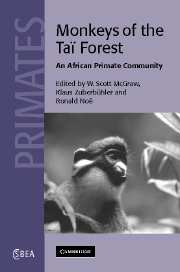Book contents
- Frontmatter
- Contents
- List of Contributors
- Preface
- 1 The monkeys of the Taï forest: an introduction
- Part I Social behavior
- Part II Anti-predation strategies
- Part III Habitat use
- Part IV Conservation
- 10 Can monkey behavior be used as an indicator for poaching pressure? A case study of the Diana guenon (Cercopithecus diana) and the western red colobus (Procolobus badius) in the Taï National Park, Côte d'Ivoire
- 11 Vulnerability and conservation of the Taï monkey fauna
- Appendix
- Index
- Plate section
- References
11 - Vulnerability and conservation of the Taï monkey fauna
Published online by Cambridge University Press: 30 July 2009
- Frontmatter
- Contents
- List of Contributors
- Preface
- 1 The monkeys of the Taï forest: an introduction
- Part I Social behavior
- Part II Anti-predation strategies
- Part III Habitat use
- Part IV Conservation
- 10 Can monkey behavior be used as an indicator for poaching pressure? A case study of the Diana guenon (Cercopithecus diana) and the western red colobus (Procolobus badius) in the Taï National Park, Côte d'Ivoire
- 11 Vulnerability and conservation of the Taï monkey fauna
- Appendix
- Index
- Plate section
- References
Summary
Conservation is in crisis. Conventional approaches have not worked. Development and conservation are on an accelerating collision course, and proposed solutions are no more than hopeful improvisations …. Instead of confronting uncertainty honestly, all too much of the conservation agenda consists of hollow and confused verbiage that promotes dogma rather than dialogue. Blindness to reality is dangerous.
(Schaller 2000:xv)What is really needed now is not further unproductive debate on whose method is the best, but agreement on what is most important and collaborative action to ensure that as much as possible is conserved.
(Mittermeier et al. 1998)Introduction
The purpose of this chapter is to identify those monkey species most vulnerable to extirpation based on criteria discussed below: the higher the cumulative score, the greater the risk a species is of disappearing. Although all primates within Taï National Park are threatened by hunting to some degree, the aim here is to indicate the probable order that Taï cercopithecids would be eliminated unless better protection is afforded them in the very near future. It is important to note that for at least two species – Procolobus badius and Cercopithecus diana – Taï National Park is the only forest in Ivory Coast containing sizable and, perhaps, any populations of these species. For this reason, their status is already vulnerable. It is also important to note that hunting pressure, levels of habitat disturbance and species abundances are not homogeneous throughout the park.
- Type
- Chapter
- Information
- Monkeys of the Taï ForestAn African Primate Community, pp. 290 - 316Publisher: Cambridge University PressPrint publication year: 2007
References
- 7
- Cited by

